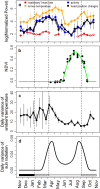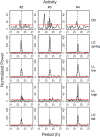Circadian rhythmicity persists through the Polar night and midnight sun in Svalbard reindeer
- PMID: 30262810
- PMCID: PMC6160466
- DOI: 10.1038/s41598-018-32778-4
Circadian rhythmicity persists through the Polar night and midnight sun in Svalbard reindeer
Abstract
Studies of locomotor activity in Svalbard reindeer reported the temporary absence of diel rhythms under Arctic photic conditions. However, using Lomb-Scargle periodogram analyses with high statistical power we found diel or circadian rhythmicity throughout the entire year in measures of behaviour, temperature in the rumen and heart rate in free-living Svalbard reindeer. Significant diel rhythmicity was only lacking during some of the 15-day intervals analysed in the less frequently measured heart rate. During Polar Night these rhythms were free-running and attenuated. During continual daylight in summer, rhythms where entrained to 24 hours corresponding with the daily variation in the intensity of solar radiation, but attenuated when continuous daylight coincided with the period of growing forage. Diel rhythmicity was reduced during this short period of peak foraging activity, which coincided with peak heart rate and temperature in the rumen, most likely to facilitate fattening when food is abundant. For the rest of the year, heart rate and temperature showed the most pronounced and long-lasting suppression ever found in ungulates. The profound seasonal changes in foraging, metabolic activity, and power of diel and circadian rhythmicity of Svalbard reindeer can be viewed as adaptations to the extreme living conditions in the High Arctic.
Conflict of interest statement
The authors declare no competing interests.
Figures






References
-
- Van der Wal R, Stien A. High-arctic plants like it hot: a long-term investigation of between-year variability in plant biomass. Ecology. 2014;95:3414–3427. doi: 10.1890/14-0533.1. - DOI
-
- Parker KL, Barboza PS, Gillingham MP. Nutrition integrates environmental responses of ungulates. Funct. Ecol. 2009;23:57–69. doi: 10.1111/j.1365-2435.2008.01528.x. - DOI
-
- Arnold, W. In Life in the Cold III: Ecological, Physiological, and Molecular Mechanisms (eds Carey, C., Florant, G. L., Wunder, B. A. & Horwitz, B.) 65–80 (Westview Press, 1993).
Publication types
MeSH terms
LinkOut - more resources
Full Text Sources
Other Literature Sources

